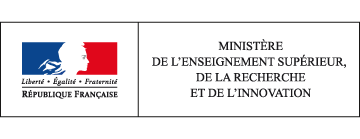49 France technological position through its patents
In 2014, France maintained its fourth position for the number of patents filed at the European Patent Office, despite a general decline in the European Union countries and an upsurge by new players like China and Korea. By contrast, the number of EU patents, and therefore of French patents, filed with the American Office has increased rapidly since 2010, underlining the appeal of the American market.
In 2014, close to 140,000 patent applications were filed with the EPO. Applications slowed down considerably after an average 4% growth between 2004 and 2009. The share of European Union countries, Japan and the United States fell in the decade 2004-2014. The share of the European Union fell from 45% in 2004 to 42% in 2014 (chart 49.01). This decline is linked to the dynamism of new countries entering the system - Korea in the 2004-2008 period, then China, India and Taiwan.
The number of patent applications to the EPO by European Union countries, Japan and the United States fell from 2008 to 2011 (chart 49.02a). EU applications increased once more from 2012 onwards, but at a slower rate than before the economic crisis. Patents issued by the American office have followed a different path (chart 49.02b): they fell until 2009 before increasing again, thereby underlining the appeal of the American market, especially for digital technologies.
Within the European Union, the share of Germany, France and the United Kingdom in the EPO applications has dropped since 2004, from 31% to 27% (chart 49.03). In other European Union countries, the share increased from 11% to 12%. In 2014, Germany accounted for 17% of EPO patent applications, followed by France (6.3%), United Kingdom (4.1%) and Italy (3.2%). France is the only one of these four countries to have maintained its share since 2009.
A review of the technological specialisation based on EPO patent applications shows that the European Union, United States and, to a lesser extent, Japan file in a wide range of technologies and therefore have moderately-sized specialisation indices. In 2014, the indices were below 2, except for Japan which show an extensive specialisation in optics. These profiles of the most technologically developed countries contrast with those of the new countries entering the system. For example, China’s profile reveals an extensive specialisation in Digital communication (specialisation index of 5.03) in contrast to a lesser specialisation in Biological material analysis (0.22).
The European Union, United States and Japan have a variety of specialisation profiles in the subject areas. The United States are highly specialised in information technology methods for management, medical technology, pharmaceutical products and biotechnology (chart 49.04). Japan is highly specialised in optics and also in audiovisual techniques and semi-conductors, certain materials and certain machines. The European Union seems to specialise in civil engineering, handling, mechanical components, transport and furniture.
Compared with Germany and the United Kingdom, and excluding the subject area microstructure technology, nanotechnology which only has a very few patents, France only appears to be highly specialised in transport, where it is slightly more specialised than Germany (chart 49.05). Germany is also highly specialised in machinery and tooling and mechanical components. The United Kingdom has different highly-specialised subject areas: basic telecommunication techniques and biological material analysis.
Carpentier Catherine, Émilie-Pauline Gallié, Françoise Laville & Frédérique Sachwald
How to cite this paper :
close
Key figure
49.01 Change in the number of European patent applications by country of the inventor (2004, 2009, 2014)
1 Other non-EU countries including Taiwan, India, Canada.
You can embed this chart to your website or your blog by copying the HTML code and pasting it into the source code of your website / blog:
close
49.02a Variation in the number of patents registered in the European system for the European Union, Japan and the United States (Year N-Year (N-1), in number of patents)
You can embed this chart to your website or your blog by copying the HTML code and pasting it into the source code of your website / blog:
close
49.02b Variation in the number of patents issued by the USPTO for the European Union, Japan and the United States (Year N-Year (N-1), in number of patents)
You can embed this chart to your website or your blog by copying the HTML code and pasting it into the source code of your website / blog:
close
49.03 Evolution of the share of Germany, France, United Kingdom, Italy and other European countries in European patents according to the country of the inventor in 2004, 2009, 2014 (%)
You can embed this chart to your website or your blog by copying the HTML code and pasting it into the source code of your website / blog:
close
49.04 'Differentiating' specialization by subdomain in the European system - comparison United States, European Union and Japan in 2014
You can embed this chart to your website or your blog by copying the HTML code and pasting it into the source code of your website / blog:
close
49.05 'Differentiating' specialization by subdomain in the European system - comparison France, Germany, United Kingdom in 2014
You can embed this chart to your website or your blog by copying the HTML code and pasting it into the source code of your website / blog:
close
Related statistical publication
 Atlas des brevetsAtlas des brevets - 2017 - - (dir.), (ed.), collective workFranck DazinMarie-Anne JanLaurence JolyPatrick MarchegayJérémy PéglionEmmanuel Weisenburger
Atlas des brevetsAtlas des brevets - 2017 - - (dir.), (ed.), collective workFranck DazinMarie-Anne JanLaurence JolyPatrick MarchegayJérémy PéglionEmmanuel Weisenburger Translation
 Etat de l'enseignement supérieur et de la rechercheL'état de l'Enseignement supérieur et de la Recherche en France n°10 - Avril 2017
Etat de l'enseignement supérieur et de la rechercheL'état de l'Enseignement supérieur et de la Recherche en France n°10 - Avril 201749 - la position technologique de la France - Carpentier Catherine, Émilie-Pauline Gallié, Françoise Laville & Frédérique Sachwald




